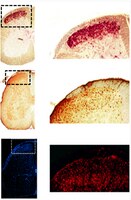Ebf1 and c-Myb repress rag transcription downstream of Stat5 during early B cell development.
Timblin, GA; Schlissel, MS
Journal of immunology (Baltimore, Md. : 1950)
191
4676-87
2013
Show Abstract
The temporal control of RAG (Rag) expression in developing lymphocytes prevents DNA breaks during periods of proliferation that could threaten genomic integrity. In developing B cells, the IL-7R and precursor B cell Ag receptor (pre-BCR) synergize to induce proliferation and the repression of Rag at the protein and mRNA levels for a brief period following successful Ig H chain gene rearrangement. Whereas the mechanism of RAG2 protein downregulation is well defined, little is known about the pathways and transcription factors that mediate transcriptional repression of Rag. Using Abelson murine leukemia virus-transformed B cells to model this stage of development, we identified early B cell factor 1 (Ebf1) as a strong repressor of Rag transcription. Short hairpin RNA-mediated knockdown of either Ebf1 or its downstream target c-Myb was sufficient to induce Rag transcription in these highly proliferative cells. Ebf1 and c-Myb antagonize Rag transcription by negatively regulating the binding of Foxo1 to the Rag locus. Ebf1 accomplishes this through both direct negative regulation of Foxo1 expression and direct positive regulation of Gfi1b expression. Ebf1 expression is driven by the IL-7R downstream effector Stat5, providing a link between the negative regulation of Rag transcription by IL-7 and a novel repressive pathway involving Ebf1 and c-Myb. | 24068669
 |














